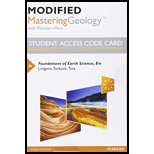
a)
The period (the time it takes to orbit the Sun) of an imaginary planet that orbits the Sun at a distance of 10 AU.
a)
Answer to Problem 1GST
The period of an imaginary planet that orbits the Sun at a distance of 10 AU is 31.6 years.
Explanation of Solution
The square root of the orbital period of a planet is equal to the cube root of its mean solar distance.
Kepler’s third law states that “the planet’s orbital period squared is equal to its mean solar distance cubed”. Thus, the solar distances of the planets can be calculated if their orbital periods are known.
For example, the orbital period of Mars is 1.88 years, and 1.88 squared equals 3.54. The cube root of 3.54 is 1.52, and that is the mean distance from Mars to the Sun, in astronomical units.
This can be expressed in the given formula:
Here, p denotes orbital period, and d denotes the mean distance from the Sun.
Substitute 1 AU in d.
Therefore, the orbital period of an imaginary planet is 31.6 years.
b)
The distance between the Sun and a planet with a period of 5 years.
b)
Answer to Problem 1GST
The distance between the Sun and a planet with a period of 5 years is 2.92 AU.
Explanation of Solution
The square root of the orbital period of a planet is equal to the cube root of its mean solar distance.
Kepler’s third law states that “the planet’s orbital period squared is equal to its mean solar distance cubed”. Thus, the solar distances of the planets can be calculated when their periods of revolution are known.
For example, the orbital period of Mars is 1.88 years, and 1.88 squared equals 3.54. The cube root of 3.54 is 1.52, and that is the mean distance from Mars to the Sun, in astronomical units.
This can be expressed as follows:
Here, p denotes orbital period, and a denotes the mean distance from the Sun.
The above expression can be written as follows:
Substitute 5 years for p in the above expression.
Therefore, the distance between the Sun and a planet is 2.92 AU.
c)
Whether one body or both the bodies will complete its orbit around the Sun in less time where one body is twice as large as the other orbiting the Sun at the same distance.
c)
Answer to Problem 1GST
Kepler’s third law does not take mass into consideration. This law states that both bodies will complete their orbits around the sun in the same orbital period. Newton’s law states that a body that contains greater mass will orbit more gradually.
Explanation of Solution
Kepler’s third law states that “the planet’s orbital period squared is equal to its mean solar distance cubed”. Thus, the solar distances of the planets can be calculated when their periods of revolution are known.
For example, the orbital period of Mars is 1.88 years, and 1.88 squared equals 3.54. The cube root of 3.54 is 1.52, and that is the mean distance from Mars to the Sun, in astronomical units.
According to Kepler’s third law, both the bodies will complete their orbits around the Sun in the same period, as the law does not take mass into consideration. However, Newton’s law states that a body with greater mass will orbit more slowly.
Want to see more full solutions like this?
Chapter 15 Solutions
Modified Masteringgeology With Pearson Etext -- Standalone Access Card -- For Foundations Of Earth Science Format: Access Card Package
 Applications and Investigations in Earth Science ...Earth ScienceISBN:9780134746241Author:Edward J. Tarbuck, Frederick K. Lutgens, Dennis G. TasaPublisher:PEARSON
Applications and Investigations in Earth Science ...Earth ScienceISBN:9780134746241Author:Edward J. Tarbuck, Frederick K. Lutgens, Dennis G. TasaPublisher:PEARSON Exercises for Weather & Climate (9th Edition)Earth ScienceISBN:9780134041360Author:Greg CarbonePublisher:PEARSON
Exercises for Weather & Climate (9th Edition)Earth ScienceISBN:9780134041360Author:Greg CarbonePublisher:PEARSON Environmental ScienceEarth ScienceISBN:9781260153125Author:William P Cunningham Prof., Mary Ann Cunningham ProfessorPublisher:McGraw-Hill Education
Environmental ScienceEarth ScienceISBN:9781260153125Author:William P Cunningham Prof., Mary Ann Cunningham ProfessorPublisher:McGraw-Hill Education Earth Science (15th Edition)Earth ScienceISBN:9780134543536Author:Edward J. Tarbuck, Frederick K. Lutgens, Dennis G. TasaPublisher:PEARSON
Earth Science (15th Edition)Earth ScienceISBN:9780134543536Author:Edward J. Tarbuck, Frederick K. Lutgens, Dennis G. TasaPublisher:PEARSON Environmental Science (MindTap Course List)Earth ScienceISBN:9781337569613Author:G. Tyler Miller, Scott SpoolmanPublisher:Cengage Learning
Environmental Science (MindTap Course List)Earth ScienceISBN:9781337569613Author:G. Tyler Miller, Scott SpoolmanPublisher:Cengage Learning Physical GeologyEarth ScienceISBN:9781259916823Author:Plummer, Charles C., CARLSON, Diane H., Hammersley, LisaPublisher:Mcgraw-hill Education,
Physical GeologyEarth ScienceISBN:9781259916823Author:Plummer, Charles C., CARLSON, Diane H., Hammersley, LisaPublisher:Mcgraw-hill Education,





